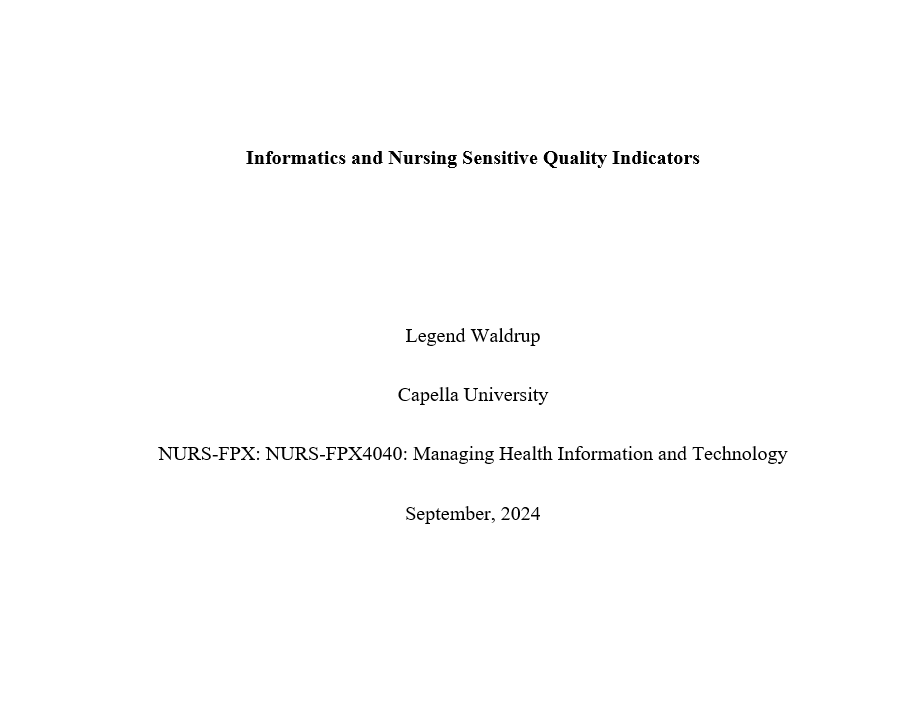Capella University
NURS-FPX: NURS-FPX4040: Managing Health Information and Technology
September, 2022
Informatics and Nursing Sensitive Quality Indicators
Hello everyone. Thank you for being part of this session. I will address you on the importance of nursing-sensitive quality indicators. The concept reinforce healthcare professionals’ commitment to delivering quality and safe care across the continuum. The American Nursing Association developed the National Database of Nursing Quality Indicators (NDNQI) to enable entities evaluate staff performance based on patient outcomes. Ju et al. (2018) indicated that the indicators encourage healthcare professionals to help their organizations identify elements that influence patient outcomes. The data provides evidence-based guidelines that helps the workforce enhance quality outcomes.
Using Quality Indicators Enhance Quality and Safety Standards
Healthcare providers utilize the information to initiate quality improvement plans and redesign protocols to optimize care outcomes. The indicators include process, structures, and outcome aspects. Knowledge of the three reinforces nurse ability to make informed decisions on the pathways for optimizing patient experiences (Ju et al., 2018). Structure indicators include resources availability, workforce qualification, and administrative programs available to improve quality of care. Process indicators are activities and deliverables that influence job satisfaction. Outcome indicators show the level of patient satisfaction. For this presentation, I will focus on nurse turnover as a staffing measure that determine the quality of care delivered across the continuum. Nurse turnover arises when a nurse decides to leave the organization for various reasons such as the pursuit for better incentives, retirement, and changing profession.
The decision to leave exposes the hospital to increased costs, unsafe staffing, increased workload, and stress for the remaining team (Perry et al., 2018). Additional outcomes include reduced patient satisfaction scores, higher patient morbidity and mortality due to increased errors, and reduced quality of care. The facility has made significant progress in addressing turnover by implementing flexible working hours and financial incentives necessary for retaining the workforce. However, the rates remain unfavorable, creating the need for nurses to play active roles in sharing accurate and adequate details about risk factors and evidence-based interventions. With continuous turnover and turnover intentions, patients, the remaining team, and the organization suffer from lost teamwork and confidence. Thus, reducing turnover is a priority for facilities seeking to deliver evidence-based care.
Interdisciplinary Team’s Roles in Collecting and Reporting Quality Indicator Data
First, it is crucial to understand interdisciplinary collaboration and nurses’ contribution in data collection and analysis. The concept allows nurses, physicians, clinical assistants, and other parties to share ideas, skills, and experiences on issues in the clinical environment. The collective efforts make it easier for healthcare providers to understand gaps and improvements necessary to optimize care outcomes (Kaddourah et al., 2018). Healthcare professionals from multiple disciplines communicate each other’s unique perspectives in delivering the safest and highest quality of care. As part of the care team, nurses exploit opportunities for interdisciplinary collaboration.
Nurses collaborate with other professionals to remove barriers to practice, promote diversity, and improve data sharing. Due to the adverse impacts of nurse turnover, different healthcare professionals can share ideas, knowledge, and experiences on the causes, implications, and evidence-based interventions (Oner et al., 2021). The quality assurance departments in collaboration with the HR and nurse managers can utilize health information systems, which has advanced documentation features for managing, collecting, storing, and disseminating information. Practice management software is appropriate to capture administrative aspects, including data on nurse turnover. The system allows physicians, nurses, clinical assistants, and other members of the care team to make informed conclusions on nurse turnover and consequences on the workforce productivity and efficiency.
Concerning nurse turnover, the practice management software captures data related to trends in staffing levels. The tool enhances accuracy of the information by aggregating data from various sources, including HR details on turnover and reports by the nurse manager and physicians. In the end, the care team will understand staffing issues, causes, and sustainable measures necessary to overcome the risk of losing competent and dependable staff. The practice management software facilitates better access, collection, and display of accurate data. The tool also allows different healthcare professionals to share evidence of declining productivity and efficiency and the need for better staffing levels. Specifically, nurses, physicians, and clinical assistants can initiate conversations on turnover trends. The team deliberates on comprehensive frameworks for monitoring turnover across the facility. Scalability of practice management software is crucial to allow more staff to share details on turnover and implications on quality and safety of outcomes.
Nurses’ Roles in Promoting Accurate Collection and Reporting of Data
Nurses’ frontline roles allow them to use their diverse competencies to achieve strategic goals. The nursing team collaborates with other healthcare professionals to highlight goals such as the need for adequate staffing. Thus, for data collection, nurses coordinate with health leaders, physicians, pharmacists, and others to share input on turnover trends (Perry et al., 2018). Nurses help their organization synthesize information on working environment, incentives, personal issues, and other factors associated with turnover. Specifically, nurses should report to their managers or physicians about productivity and efficiency issues related to staffing levels.
Nurses should also record data on staffing issues with the workplace and their implications on quality and safety of patient care. An interview with the HR and a nurse manager revealed the need for nurses to utilize innovative ways of sharing details about events in their working environment. The Press Ganey survey allows nurses and other healthcare professionals to share information on reasons for increasing turnover. The tool includes a list of questions asking nurses about their experiences within the workplace. The questions may include details of the care team’s feelings about their organization, including what they think about policies, procedures, and structures in place to determine nursing practice. The goal is to ensure that the facility has a nurse workforce more engaged with their jobs and committed to producing the intended quality. Thus, completing surveys sent to your emails by the quality assurance department enhances access to credible and reliable information on nurse turnover and necessary improvements.
Your role is to provide accurate and adequate information to facilitate informed conclusions about the issue. Collaborating with office staff and the HR is crucial since the group helps capture and process information about events in the clinical environment. For instance, the HR synthesizes data received from nurse managers, team leaders, departmental heads, and others. The HR and health leaders have an in-depth view of staffing issues across the facility and the need to utilize practice management software and Press Ganey survey to capture reasons, consequences, and viable solutions for turnover problems.
Thus, nurses should help the organization track staffing issues and health outcomes associated with working in an understaffed unit. The organization depends on you as part of the interdisciplinary team to share information on risk factors associated with intention to leave. It is important to make observations and express your opinions on measures the facility could take to improve the current situation. I encourage you to take time and respond to survey questions sent to your emails or conversations initiated by leaders to understand scenarios that could trigger staff turnover. Acknowledging efforts to initiate and sustain proactive employee engagement will strengthen your roles in delivering the desired quality across the continuum. Additionally, you can use your knowledge and experiences to help the facility improve procedures, policies, and structures associated with nurse turnover. The commitment to sharing accurate and adequate details on events in the working environment will boost personal and professional competencies.
As I conclude, I welcome you to this organization and hope that you will dedicate time and energy towards delivering safe and quality patient care. Nurses’ frontline roles and extensive knowledge of the healthcare system makes them key part of interdisciplinary collaboration. The experiences reveal the need for nurses to support data collection processes meant to capture scenarios in the clinical environment. You should actively participate in surveys, team sessions, briefings, and other activities that allow their organization to understand quality gaps, causes, and evidence-based solutions. For example, increased nurse turnover calls for collective participation in identifying the motivations for employees leaving the organization. Participating in surveys that allow you to raise concerns about work-life balance, compensation, family issues, and other causes of turnover. Failure to participate in the data collection process limits the organization from delivering high standards of care due to inadequate staffing for inpatient and outpatient care.
References
Ju, Q.Y., Huang, L.H., Zhao, X.H., Xing, M.Y., Shao, L.W., Zhang, M.Y., & Shao, R.Y. (2018). Development of evidence‐based nursing‐sensitive quality indicators for emergency nursing: A Delphi study. Journal of Clinical Nursing, 27(15-16), 3008-3019. https://pubmed.ncbi.nlm.nih.gov/29314311/
Kaddourah, B., Abu-Shaheen, A., & Al-Tannir, M. (2018). Quality of nursing work life and turnover intention among nurses of tertiary care hospitals in Riyadh: A cross-sectional survey. BMC Nursing, 17(43), 1-6. https://bmcnurs.biomedcentral.com/articles/10.1186/s12912-018-0312-0
Oner, B., Zengul, F., Oner, N., Ivankova, N., Karadag, A., & Patrician, P. (2021). Nursing-sensitive indicators for nursing care: A systematic review (1997-2017). Nursing Open, 8, 10005-1022. https://www.ncbi.nlm.nih.gov/pmc/articles/PMC8046086/
Perry, S. J., Richter, J., & Beauvai, B. (2018). The effects of nursing satisfaction and turnover cognitions on patient attitudes and outcomes: A three‐level multisource study. Health Services Research, 53(6), 4943-4970. https://www.ncbi.nlm.nih.gov/pmc/articles/PMC6232403/pdf/HESR-53-4943.pdf



